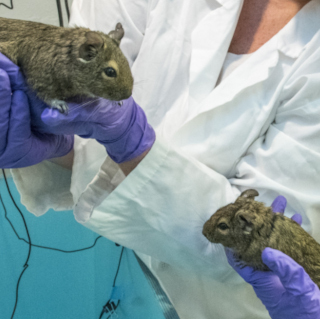Anesthetic Waste Gas Scavenging
Last Review Date: October 25, 2022
I. Purpose
The purpose of this policy is to protect the health of persons working with or near anesthetic gases used in animal research at the University of Montana. Volatile anesthetic waste gases are minimized through training in anesthetic administration, using the smallest amount of gas necessary, maintaining gas anesthetic equipment in proper working order, scavenging anesthetic waste gases, and monitoring worker exposure.
II. Policy Procedure
Approved Inhalant Anesthetic Agents
Isoflurane is the approved volatile halogenated anesthetic agent at the University of Montana. Isoflurane may also be used for euthanasia with proper approval from the Institutional Animal Care and Use Committee.
Anesthetic Training
Training to ensure the safety of animals being anesthetized and of the persons in the area must be provided by one of the following: 1) Principal Investigator (PI), 2) Attending Veterinarian, 3)Laboratory Animal Resources (LAR) staff, or 4)a trained and experienced scientific laboratory member approved under the animal use protocol (AUP). Training should include checking the anesthetic circuit for leaks, operating vaporizers at their lowest settings necessary for maintaining adequate anesthesia, use of scavenging equipment, and animal monitoring.
Equipment Maintenance
Vaporizers are fully cleaned and calibrated by an authorized exchange service center every 3 years. In the years between the exchange, vaporizers are examined by a certified technician using leak and delivery accuracy testing on-site (Anesthesia Equipment Supply, Inc, Black Diamond, WA). In both cases, vaporizers are marked with a sticker indicating the date of testing or the date of next needed maintenance. Maintenance is scheduled through LAR or verification provided in writing to the Facility Manager of LAR.
Waste Gas Scavenging
When using an anesthetic vaporizer, waste gas should be scavenged actively through a house vacuum, passively using a charcoal canister, or actively and passively [e.g., active anesthetic evacuation system (A.E.S., Surgivet) feeding a charcoal canister]. Additionally, endotracheal tubes (when appropriate) should have cuffs to prevent leakage, or ensuring that animal face masks fit snugly on the muzzle of the animal.
When using the open-drop method (e.g., a closed jar containing gauze with anesthetic dripped on it), the
Worker Exposure Monitoring
In the absence of established national guidelines for isoflurane exposure (see below), it is our practice to use 2 ppm as an institutional recommended exposure limit (REL). Monitoring of personnel using badges clipped to clothing in the breathing zone will be periodically measured for all new anesthetic equipment or each new area of anesthetic use to verify that typical exposures are below the REL. Changes in equipment or experimental conditions warrant additional monitoring. It is the responsibility of the PI to inform the IACUC of such changes.
The United States Department of Labor, Occupational Safety and Health Administration has published a document entitled "Anesthetic Gases: Guidelines for Workplace Exposures" at http://www.osha.gov/dts/osta/anestheticgases/index.html#I. According to this document,
"In 1997, the National Institute for Occupational Safety and Health (NIOSH) . . . recommended that no worker should be exposed at ceiling concentrations greater than 2 ppm of any halogenated anesthetic agent over a sampling period not to exceed one hour (NIOSH 1977). In 1989, the American Conference of Governmental Industrial Hygienists (ACGIH) assigned a threshold limit value-time-weighted average (TLV-TWA) for . . . halothane and enflurane, and are 50 ppm and 75 ppm, respectively. No NIOSH recommended exposure limits (REL) exist for the three most currently used anesthetics (isoflurane, desflurane, and sevoflurane). The levels of risk for isoflurane, desflurane, and sevoflurane have not been established. Since there are limited data, occupational exposure limits for these agents have not been determined. Therefore, until more information is available, it is prudent to attempt to minimize occupational exposure to these as with all anesthetic agents."
